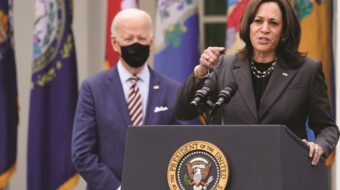Opinion
“César Chávez? Oh, yeah, wasn’t he a great boxer?” This is an all too common answer to the question, “Who was César Chávez?”
César Estrada Chávez was a Mexican American labor leader, civil rights activist and is a hero to millions of working people everywhere. He was a short, brown man, but when it came to fighting for his people, he stood and delivered justice like a giant.
For decades, Mexican Americans have fought hard against exploitation and for equal rights at work and in society, and Chavez best symbolizes that fight. His mother, Juana Estrada, his first source of faith in non-violent spirituality in the cause of justice, grew up here in Tucson.
Born in Yuma, Ariz., in 1927, César attended schools that had “whites-only” signs. While in school, teachers hit him on his knuckles with a ruler for speaking Spanish. He attended 37 schools because his family had to follow the crops in order to work and survive. César had to quit school in the eighth grade to help support his family.
Having lost their family ranch in the Gila valley during the Great Depression, the Chavezes, led by Librado and Juana, left Arizona in search of work in California’s fields.
César, along with his parents and siblings, would often sleep in their car because they were so poor. In fact, it was the intense poverty, racism, exploitation, and oppression he experienced as a child laboring in those “factories in the fields” that would foment the seeds of his monumental desire for justice.
As a young man in California, César was kicked-out of a movie theater for sitting in the “whites-only” section. He protested so strongly that he got arrested. In cities and towns throughout the southwest, Mexican Americans couldn’t sit alongside whites at the movies during the 1940s and ’50s.
After serving in the U.S. Navy, César became a leader for the Community Service Organization. As a leader of this group, César registered and mobilized thousands of Chicanos in California to vote. He organized protests against racial discrimination.
Chávez’s greatest legacy is his work organizing farmworkers. Despite great opposition and defying many who doubted him, César, along with Dolores Huerta, successfully established the United Farm Workers of America, known as the UFW. Under the slogan, “Sí, Se Puede” (Yes, we can), Chavez’s strategies and tactics in building this new type of union involved religious fasts, boycotts, long marches, and strikes. He, like Dr. Martin Luther King, Jr., advocated a non-violent struggle for justice.
On April 23, 1993, César died unexpectedly in his sleep at a farmworker’s home in San Luís, Arizona, not far from where he was born. Earlier on the date of his death, César had been arguing in court in favor of farmworkers’ rights to boycott the Bruce Church Lettuce Corporation in Arizona. That evening, he told his friends that he felt unusually tired and went to lie down. He fell asleep with the light on and fully dressed. When discovered the next morning, his lifeless, yet peaceful, grasp held a book on Native American art.
His premature death shocked us all. Over forty thousand people attended his funeral in California. His legacy remains for us to remember, and his work remains for us to continue. ¡Sí, Se Puede!
Ray Siqueiros is the chairman of the Third Annual Peace and Justice/Cesar Chavez Day March and Rally in Tucson and can be reached at pww@pww.org
PDF version of ‘Who was César Chávez?’











Comments